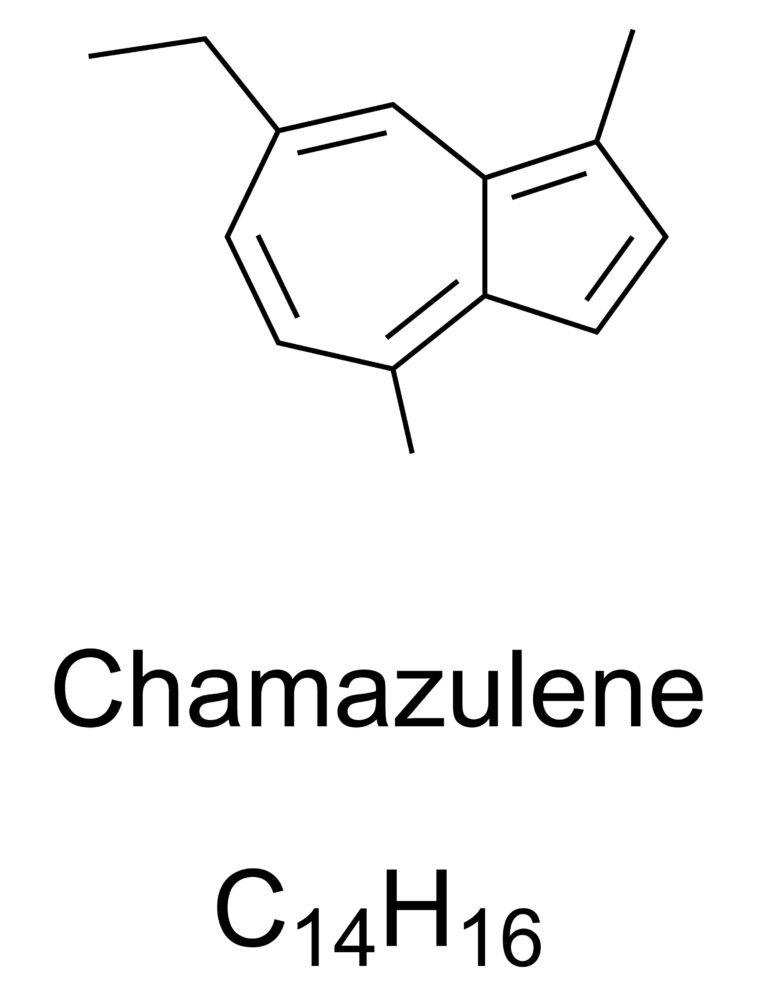Chamazulene

If you break down the term chamazulene into its constituent parts, you can already guess what it is. ‘Cham’ is derived from ‘chamomile’, which is the Latin name for the plant. The middle syllable ‘azu’ stands for azure, i.e. the colour sky blue, and ‘len’ for ‘alkene’, a chemical compound. But real chamomile isn’t sky blue! That’s right, the striking colour is only created during the extraction and distillation of the chamomile flowers! Chamazulene is an important component of the essential chamomile flower oil. Chemically speaking, it is a terpene derivative and belongs to the group of polycyclic aromatic hydrocarbons. Its structure could only be elucidated in 1953.
In chamomile itself, or rather in the individual flowers, the precursor, the sesquiterpene matricin, is present, which we also find in yarrow. During steam distillation, matricin splits off water and a molecule of acetic acid. This initially produces chamazulene carboxylic acid, which has a deep black-blue colour. Chamazulene is formed by further heating of chamazulene carboxylic acid. Matricin itself is colourless. Chamazulene, which is obtained from chamomile by steam distillation, is said to have a wide range of effects, especially on a physical level. Around 300 kilograms of chamomile flowers are needed to produce one kilogram of chamomile oil.
The effect of chamazulene
Essential camomile oil has anti-inflammatory, calming and antispasmodic properties. It is often used in combination with other herbal agents (such as clary sage and yarrow) to treat stomach upsets and period pains. This ingredient is of medical interest because it can inhibit the activity of the enzyme CYP1A2, which occurs in the liver.
It can also help to alleviate the symptoms of ear and nappy eczema and promote healing. In addition, it has proven helpful in many cases of other poorly healing wounds. Ideally, essential oil with chamazulene is diluted and applied as a compress or on a cotton ball. However, bath additives with chamazulene also have a beneficial effect.
Cosmetic effects and possible uses
The soothing and anti-inflammatory effect is, of course, also ideal for skin care. The active ingredient often provides good results for acne and other skin impurities. It is also suitable for sensitive and delicate skin, as it can accelerate the reduction of redness and irritation and alleviate annoying itching. Other areas of application are dry and mature skin. Chamomile can also combat premature skin aging because researchers have found that it has an antioxidant effect: Interestingly, in-vitro studies have shown that the peroxidation system is inhibited. (Source: https://www.pharmazeutische-zeitung.de/titel-05-2003/).
How well chamazulene actually works also depends, of course, on the quality of the product. Ideally, the essential oil should be organically grown. Chamazulene is generally considered to be a well-tolerated and safe active ingredient. Allergic reactions occur only rarely, and if they do, they affect mainly people who are already allergic to plants in the daisy family. If you are unsure, you can test skin care products with chamomile on a small area of skin, such as the inside of your arm.
Chamazulene: a brief profile
INCI: Chamazulene
Alternative name: 7-Ethyl-1,4-dimethylazulene
Description: initially brown-black, turns blue after distillation
CAS number: 529-05-5
EC number: 208-449-6
Molecular formula: C14H16
Boiling point: 161 degrees Celsius
Melting point: 127 to 129 degrees Celsius
Solubility: highly soluble in ethanol, n-hexane and methanol
Possible uses: as an anti-inflammatory base for high-quality skin creams, for the care of irritated, blemished and sensitive skin.
An active ingredient with many good properties
Even though chamazulene, with its intense blue colour, looks unusual at first glance, the active ingredient is nevertheless of natural origin. Its precursor, matricin, which also has an anti-inflammatory effect, is found mainly in chamomile but also in yarrow, and has anti-inflammatory and antioxidant properties. The substance is particularly suitable for care products for sensitive, irritated, blemished, dry and mature skin. You can find more detailed information about the active ingredient at Cosmacon.